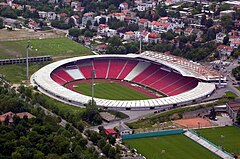Football in Serbia
This article has multiple issues. Please help improve it or discuss these issues on the talk page. (Learn how and when to remove these template messages)
|
| Football in Serbia | |
|---|---|
 Home stadium of club Red Star Belgrade | |
| Country | Serbia |
| Governing body | Football Association of Serbia |
| National team(s) | Serbia national football team |
| First played | 1896 |
| Registered players | 120,194 |
| Clubs | 2,770 |
National competitions | |
Club competitions | |
International competitions | |
| |
The FSS is also responsible for organizing the Serbian Cup, the country's league cup competition. It has been played from the end of the 19th century and there were a number of very successful Serbian football players and coaches throughout history.
One of Serbia's top football clubs
History
This section needs expansion with: more notable events. You can help by adding to it. (February 2011) |
Kingdom of Serbia
Football first came to
The inaugural meeting of the First Serbian Football Society (Prvo srpsko društvo za igranje loptom) took place on 1 May 1899, at the restaurant Trgovačka kafana, at initiative of Hugo Buli, and with support of Andra Nikolić, who was then Minister of Foreign Affairs in the Kingdom of Serbia. Feti Bey, the Turkish consul in Belgrade, was elected as President, and the lawyer Mihailo Živadinović as the Vice-President. In spring 1899, the first football field was built in the Topčider neighbourhood of Belgrade, and the first match was played in May that year between two teams of the members of the football society.[2]
Most of the first Serbian football clubs were multi-sports societies which included football sections. The first football club was founded in
In spring 1914, the
Kingdom of Yugoslavia
At the end of the
In 1919 the
This period was marked by the mass popularization of football. The national league was dominated by clubs from Belgrade and Zagreb, but within Belgrade major rivalry was created between BSK and Jugoslavija (Reds and Blues respectively) creating what will be the
The year of 1935 marked the professionalization of football in Yugoslavia, with the replacement of amateur status to the professional one, and the introduction of contracts for players.[8]
On the assembly of the Yugoslav Football Association held on October 1, 1939, a decision was made to rename the FA into Serbian Football Association, after earlier that year the FA's of Croatia and Slovenia were formed, and the delegates of Ljubljana, Osijek, Split and Zagreb subassociations decided to abandon the Yugoslav Football Association.[9]
Socialist Yugoslavia
The end of the war was the beginning of the reconstruction, and the devastated football grounds and stadiums, as well as the football clubs needed to be restored.
Contemporary period
After the dissolution of Yugoslavia, and the separation of
Competitions
This section needs expansion. You can help by adding to it. (January 2011) |
The governing body of football in Serbia is the Football Association of Serbia. It oversees the organization of:
- Leagues:
- Serbian SuperLiga — first league
- Serbian First League — second league
- Serbian League (4 groups) — third league
- Serbian Zone League (10 groups) — fourth league
- Belgrade Zone League
- Banat Zone League
- Bačka Zone League
- Novi Sad-Syrmia Zone League
- Drina Zone League
- Dunav Zone league
- Morava Zone League
- Zone League East
- Zone League South
- Zone League West
- Serbian District League (31 leagues) — fifth league
- Serbian Intermunicipal League (52 leagues) — sixth league
- Serbian Municipal League (57 leagues) — seventh league
- Serbian Municipal Second League (6 leagues) — eighth league
- Cup tournaments:
- National teams:
Note: the aforementioned competitions are for men if not stated differently. Women's football exists but is much less developed or popular.
Teams
By far the two most popular clubs in the country are
Player of the Year
The Serbian Footballer of the Year award is an annual award given from the Football Association of Serbia to the best player of the year.
Football stadiums in Serbia
Stadiums with a capacity of 20,000 or higher are included.
| Image | Stadium | Seating capacity | City | Home team | Notes |
|---|---|---|---|---|---|
 |
Rajko Mitić Stadium | 55,568[11] | Belgrade | Crvena Zvezda | UEFA Category 4 stadium |
| Partizan Stadium | 29,775[12] | Belgrade | Partizan Belgrade | UEFA Category 3 stadium |
References
- ISBN 9780141911540. Retrieved 13 April 2018 – via Google Books.
- ^ a b Fudbal u Kraljevini Jugoslaviji, Milorad Sijić, pg. 3
- ^ Lisica, Admir. "Fudbalski misionari doveli igru na Balkan prije 120 godina". balkans.aljazeera.net (in Bosnian). Retrieved 2021-10-19.
- ^ Fudbal u Kraljevini Jugoslaviji, Milorad Sijić, pg. 4
- ^ "Srbislav Todorović: "Football in Serbia 1896 - 1918", pg. 60" (in Serbian). Ofkbeograd.net. Archived from the original on 2012-05-12. Retrieved 2012-09-11.
- ^ "The disintegration of Yugoslavia and football". University of Iowa. Retrieved 12 June 2022.
- ^ Fudbal u Kraljevini Jugoslaviji, Milorad Sijić, pag. 6
- ^ Fudbal u Kraljevini Jugoslaviji, Milorad Sijić, pag. 18
- ^ Fudbal u Kraljevini Jugoslaviji, Milorad Sijić, pags. 25 and 26
- ^ "The disintegration of Yugoslavia and football". University of Iowa. Retrieved 29 July 2022.
- ^ "Dom Crvene zvezde". crvenazvezdafk.com. Retrieved 29 December 2020.
- ^ "STADIUM". partizan.rs. Retrieved 14 April 2020.
External links
- History of Football in Serbia via the Serbian FA (archived 27 December 2011)
